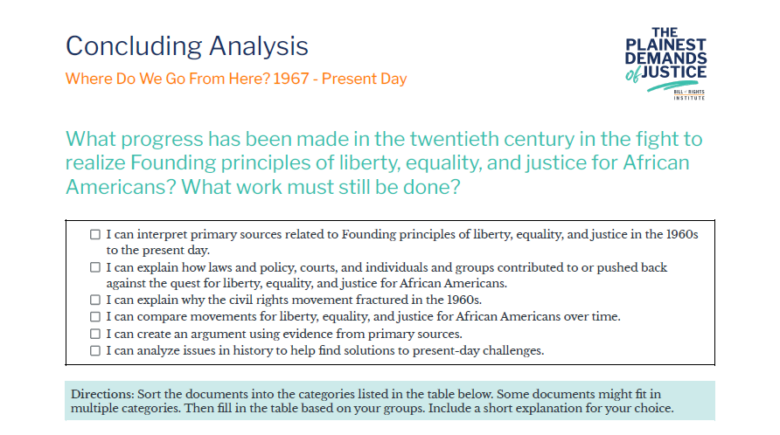Concluding Analysis: Lesson 6, Plainest Demands of Justice
What progress has been made in the twentieth century in the fight to realize Founding principles of liberty, equality, and justice for African Americans? What work must still be done?
- I can interpret primary sources related to Founding principles of liberty, equality, and justice in the 1960s to the present day.
- I can explain how laws and policy, courts, and individuals and groups contributed to or pushed back against the quest for liberty, equality, and justice for African Americans.
- I can explain why the civil rights movement fractured in the 1960s.
- I can compare movements for liberty, equality, and justice for African Americans over time.
- I can create an argument using evidence from primary sources.
- I can analyze issues in history to help find solutions to present-day challenges.
Directions: Sort the documents into the categories listed in the table below. Some documents might fit in multiple categories. Then fill in the table based on your groups. Include a short explanation for your choice.
| Document Title and Date | Laws and Policy | The Courts | “We the People” – individuals and groups |
|---|---|---|---|
| Black Panther Party “Ten Point Program,” 1966 | Party formed as a response to police brutality in Oakland, California | ||
| Stokely Carmichael and Charles Hamilton, Black Power: The Politics of Liberation in America, 1967 | |||
| Martin Luther King, Jr., “Where Do We Go From Here?”, 1967 | |||
| Images of 1968 Riots, Washington, DC | |||
| Civil Rights Act, 1968 | |||
| Tommie Smith and John Carlos at the 1968 Olympics, October 17, 1968 | |||
| Griggs v. Duke Power, 1971 | |||
| Justice Lewis Powell, Decision of the Court, Regents of U. of California v. Bakke, 1978 | |||
| Justice Thurgood Marshall Dissent, Regents of U. of California v. Bakke, 1978 | |||
| Civil Rights Act, 1991 | |||
| Barack Obama, “A More Perfect Union,” 2008 | |||
| Black Lives Matter, “Herstory,” 2014 | |||
| Fisher v. U. of Texas, 2016 | |||
| Nikole Hannah-Jones, The 1619 Project, 2019 | |||
| Robert Woodson, “The Crucial Voice of 1776,” 2020 | |||
| John Lewis, “Together, You Can Redeem the Soul of Our Nation,” 2020 |
- Explain the growing strength of the Black Power ideology and Black nationalism beginning in the mid-1960s.
- Consider the role of a leader in working for change by completing the following chart. How do the approaches and goals of these leaders compare?
Leader Frederick Douglass Booker T. Washington W.E.B. Du Bois Martin Luther King, Jr. and SCLC Goals and Approaches Leader Malcolm X and Black Nationalism John Lewis and SNCC Stokely Carmichael and Black Power Alicia Garza, Patrisse Cullors, and Opal Tometi #BlackLivesMatter Goals and Approaches - Consider the use of violence and nonviolence in the fight for civil rights. Which do you think has been more effective? Could change have been achieved with the exclusive use of one or the other? Explain your reasoning.
- How did the Supreme Court interpret the constitutionality of affirmative action in this time period? Justice Kennedy advocated “constant deliberation and continued reflection” regarding admissions policies in the court’s opinion in Fisher v. University of Texas. Are there other solutions to increase representation in higher education and professions?
- The role of history in education, particularly the framing of The 1619 Project, is widely debated today. If you had to design a history class about African Americans in the United States, what would you emphasize? What documents would you place at the center of that history? Suggest at least five documents and explain your reasoning for each.
- John Lewis challenged young people in his final words by saying: “When historians pick up their pens to write the story of the twenty-first century, let them say that it was your generation who laid down the heavy burdens of hate at last and that peace finally triumphed over violence, aggression and war.” What progress has been made in the twentieth century in the fight to realize Founding principles of liberty, equality, and justice for African Americans? What work must still be done?
